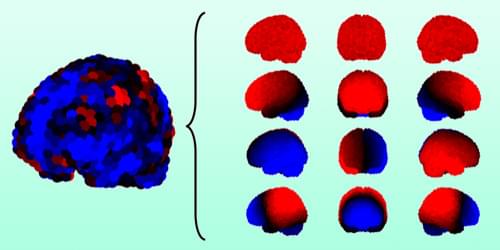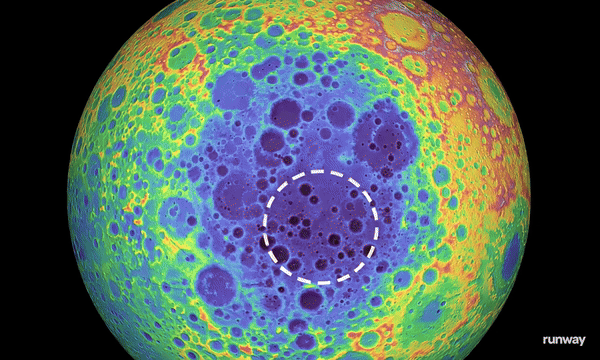A new frequency-based analysis of recordings from neurons in the brain may give insight into brain pathologies such as Parkinson’s disease.



The South Pole-Aitken Basin on the Moon’s far side is one of the most remarkable regions in our Solar System. Spanning approximately 2,500 kilometers (1,550 miles) in diameter, it’s among the largest known craters, with research interest from multiple space agencies. Among recent discoveries, planetary scientists uncovered an enormous mass anomaly beneath this basin, which could be key to understanding the Moon’s geological history. This mass anomaly, first revealed in 2019, has implications for future lunar missions and provides a window into the Moon’s formation.
Discovery of a Giant Mass Anomaly
Scientists detected the buried mass using data from NASA’s Gravity Recovery and Interior Laboratory (GRAIL) mission, which monitors changes in the Moon’s gravitational field. This unique technique enabled researchers to identify the anomaly and measure its incredible weight, estimated at around 2.18 billion billion kilograms. The mass was so dense that it caused the basin floor to dip by nearly a kilometer (more than half a mile), an indication of its massive gravitational pull. To visualize this, Peter B. James, the lead scientist from Baylor University, compared it to burying a metal structure five times the size of Hawaii underground.

Research from Yale School of Medicine indicates a strong link between air pollution levels and eczema prevalence in the U.S.
The study found that residents in high PM2.5 areas are twice as likely to develop eczema, suggesting significant health implications of air pollution on skin conditions.
A new study published today, November 13, 2024, in the journal PLOS ONE has found that people living in areas with higher air pollution are more likely to have eczema. Led by Dr. Jeffrey Cohen of Yale School of Medicine, the study explores the potential environmental impact of industrialization on skin health.
NASA and ISRO’s NISAR satellite aims to revolutionize our understanding of Earth’s surface movements with frequent global scans.
By detecting minute motions in land and ice, the satellite will enhance predictions for earthquakes and volcanic eruptions, and monitor infrastructure stability in ways previously not possible, saving significant time and resources in disaster management.
Monitoring Earth’s Movements

NASAs Voyager 2 flyby of Uranus decades ago shaped scientists’ understanding of the planet but also introduced unexplained oddities. A recent data dive has offered answers.
In 1986, Voyager 2’s flyby of Uranus caught the planet during a rare magnetic anomaly caused by unique space weather, which influenced its magnetosphere’s behavior, offering new insights into its intense radiation belts and suggesting potential activity on its moons.
Voyager 2’s Historic Uranus Flyby

Researchers at the University of Minnesota have developed a new material poised to revolutionize the next generation of high-power electronics, making them faster, more transparent, and more efficient. This engineered material enables electrons to move at higher speeds while staying transparent to both visible and ultraviolet light, surpassing previous performance records.
The research, published in Science Advances, a peer-reviewed scientific journal, marks a significant leap forward in semiconductor design, which is crucial to a trillion-dollar global industry expected to continue growing as digital technologies expand.
Semiconductors power nearly all electronics, from smartphones to medical devices. A key to advancing these technologies lies in improving what scientists refer to as “ultra-wide band gap” materials. These materials can conduct electricity efficiently even under extreme conditions. Ultra-wide band gap semiconductors enable high-performance at elevated temperatures, making them essential for more durable and robust electronics.

The business contact information for 122 million people circulating since February 2024 is now confirmed to have been stolen from a B2B demand generation platform.
The data comes from DemandScience (formerly Pure Incubation), a B2B demand generation company that aggregates data.
Data aggregation is the process of collecting, compiling, and organizing data from public sources to create a comprehensive dataset valuable for digital marketers and advertisers in creating rich “profiles” used to generate leads or marketing information.

Hackers are using a novel technique that abuses extended attributes for macOS files to deliver a new trojan that researchers call RustyAttr.
The threat actor is hiding malicious code in custom file metadata and also uses decoy PDF documents to help evade detection.
The new technique is similar to how the Bundlore adware in 2020 hid its payloads in resource forks to hide payloads for macOS. It was discovered in a few malware samples in the wild by researchers at cybersecurity company Group-IB.


There is a challenge related to prostate cancer from cancer cells that form resistance to treatments as the disease progresses. For medical science, these resistance mechanisms are not yet fully understood.
A new study by the University of Eastern Finland has filled some of this knowledge gap. The scientists found that inflammation-promoting immune cells, M1 macrophages, can transform cancer cells into stem-like cells and thus immune to treatment.
The study examined the impact of factors promoting inflammation in a tumour microenvironment on the progression of prostate cancer. Researchers focused particularly on the role of M1 and M2 macrophages in the tumour microenvironment. Macrophages are immune cells whose large number in the tumour area is often a sign of poor prognosis in relation to prostate cancer. These white blood cells stimulate the action of other immune system cells.